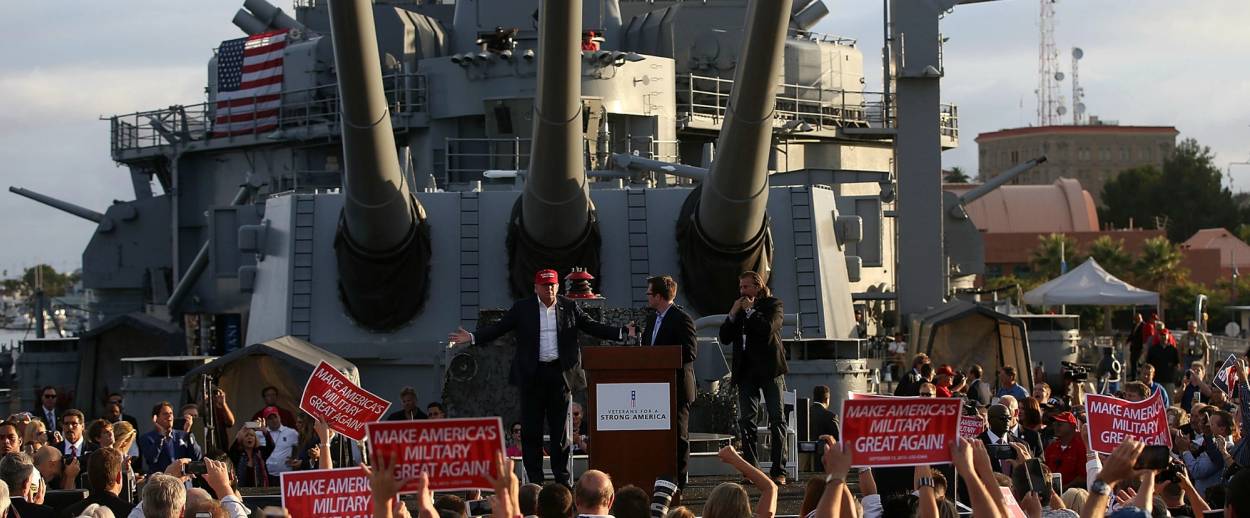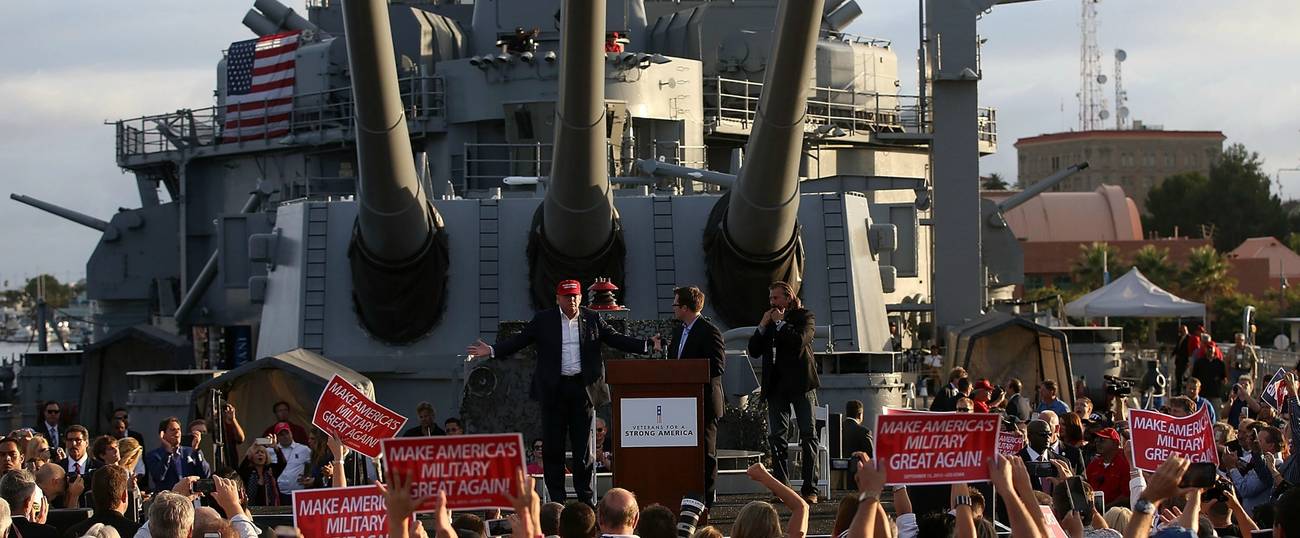During an interview with the Washington Post editorial board earlier this week, Frederick Ryan, the newspaper’s publisher, asked Donald Trump if he would consider using “battlefield” or “tactical” nuclear weapons against ISIS. The Republican presidential frontrunner replied, “I don’t want to start the process of nuclear,” before urging the Post‘s editorial board to “remember…I’m a counter-puncher. Rubio hit me. Bush hit me. When I said low energy, he’s a low-energy individual, he hit me first.”
Trump gave an off-topic response to what was really something of a trick question—one that Trump flunked “bigly.” Ryan’s question about the advisability of using tactical or battlefield nuclear weapons against ISIS operated on the premise that the U.S. actually has battlefield or tactical nuclear weapons that it could use against the group. You’d think that as both a really smart person and a self-proclaimed nuclear weapons enthusiast—the power, the devastation, is, in fact, very important to Trump—his exacting intellect would have sliced through Ryan’s misdirection.
Loser, Trump could have said, flashing his signature schadenfreude. You may write for a failing newspaper, but the Washington Post is still doing better than the U.S.’s ship, submarine, aircraft-carrier, and naval-aircraft-based tactical nuclear arsenal, which president George H. W. Bush withdrew in 1991, and better than the U.S.’s overall tactical stockpile, which has fallen to an estimated 500 warheads (some number of which are inactive, and only 180 of which are deployed), from a height of around 22,500 in the early 1960s.
Had Trump really wanted to engulf the Post‘s editorial board in a veritable fireball of nuclear wonkery, he could have delved into the moral and strategic implications of the B-61 Mod 12, the last weapon in the U.S. nuclear arsenal configured for a tactical-sized blast.
As Alex Wellerstein, a nuclear historian at the Stevens Institute of Technology and creator of the morbidly addictive Nukemap, explained by email: “The B-61 Mod 12 can go down as low as 0.3 kilotons (so 300 tons of TNT equivalent), or 5 to 10 kilotons (both ‘tactical’ depending on what you drop them on), and has been outfitted with a precision guidance tail that decreases its Circular Error Probable to something like 30 meters.”
Wellerstein noted that a .3-kiloton weapon produces a fireball of 50 meters, meaning that a 30-meter Circular Error Probable would put a chosen target within the weapon’s destructive radius 100% of the time, even when aiming “with almost arbitrary accuracy.”
Would a President Trump even want the option of using nuclear precision missiles, decades after the US decided it had no real use for tactical nukes? As Wellerstein notes, “continued US work on the B-61 weapon system is controversial,” as the weapon is “intentionally very ‘flexible’ in its yields.”
Strategic nuclear warheads, which are delivered by bomber aircraft or long-range ballistic missile, are blunt weapons, good for little more than destroying entire cities or military bases thousands of miles away. This appallingly dangerous and extremely limited range of uses helps explain why there hasn’t been an offensive nuclear strike in over 70 years.
In comparison, a small-bore B-61 has an unsettlingly wider variety of applications. It could take out a tank column, or reduce a terrorist hideout to radioactive dust. Tactical warheads give nuclear weapons an unnerving degree of banality—which, along with their burdensome upkeep costs and the lower probability of large-scale interstate warfare in Europe after the fall of the Soviet Union, probably helps explain why the U.S. has almost completely purged the weapons from its current arsenal.
Trump told the Washington Post editorial board that as president he doesn’t “want to start the process of nuclear.” Like Trump, Jewish thinkers grappling with the ethics of nuclear weaponry have often come out against first-use, determining that the possession of nuclear weapons is permissible only as a means of ensuring a country’s survival against a similarly-powerful foe. As Tablet contributor Shlomo M. Brody noted in 2015, at the height of Cold War tensions in the 1960s, future British chief rabbi Immanuel Jakobovits argued against the use of nuclear weapons in a defensive nuclear war that would end in the complete destruction of both sides, but advocated the possession of nuclear weapons for deterrent purposes. “This position was later buttressed by Rabbi J. David Bleich,” Brody writes, “who cited a Talmudic passage that prohibits a sovereign from killing in warfare more than one-sixth of the world’s population — a prospect deemed realistic in the Cold War — yet opposed unilateral disarmament.”
Tactical nuclear weapons might be worryingly flexible, but they’re useless in one of the few scenarios that would plausibly endanger the U.S.’s very existence: strategic nuclear warfare with a rival state. Battlefield nukes don’t fulfill Bleich and Jacobovitz’s moral or strategic criteria. And interestingly, a 2014 study in the Bulletin of the Atomic Scientists found that the Israeli nuclear arsenal likely consists entirely of city-busting strategic weapons, suggesting that generations of Israeli leaders have viewed the country’s nukes as a guarantor of the state’s long-term survival, rather than a viable tactical option.
In any case, Trump didn’t push back against the premise of Ryan’s question. He didn’t note the U.S.’s decision to phase out tactical weapons, or comment on the active debate over their future development.
The real estate mogul seemed no more interested in the topic when Ryan repeated his question.
“I’ll tell you one thing,” Trump said in response, “this is a very good looking group of people here. Could I just go around so I know who the hell I’m talking to?”


